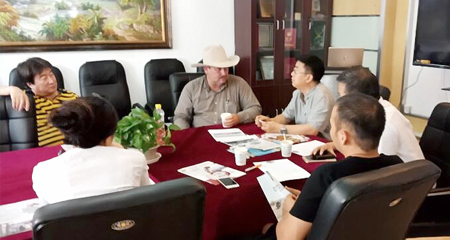AMIDST the high-level satisfaction about China’s tripling its aid and investment package to Africa announced early this month in Johannesburg, one leader was casting his net much further out, and it was one who wasn’t even there.
“I would like… to commend President Xi Jinping on the Silk Road Economic Belt and the 21st Century Maritime Silk Road initiatives he has launched. Given its geographical location, the Kingdom of Morocco could play a constructive role in extending the Maritime Silk Road, not only to ‘Atlantic Europe’, but also and especially to West Africa nations, with whom my country has multi-dimensional ties,” Morocco king Mohammed VI said in his speech read by Government chief Abdelilah Benkirane.
Mohammed has read the signs of the times: underneath the economic focus of the Forum on China-Africa Cooperation (FOCAC) summit was the reality of China preparing the African ground for the extension of its new aggressive foreign policy, which seeks to make the Asian country a global powerhouse and shift the balance from a US-dominated polarity.
New real estate for AU
A new conference centre would also be built for the African Union, in addition to an upper limit of five economic cooperation zones.
The relationship has grown meteorically since, with state-funded companies muscling out the private sector and the rhetoric changing, as Beijing realised the clout that it could build on a continent seeking economic alternatives. The strengthened ties are seen as a pillar of the continent’s rise since the turn of the century.
The Johannesburg summit was followed avidly for two main reasons. First, following years of a super-cycle that saw China import massive amounts of African resources, providing a tailwind for Africa’s growth in the last 10 years, this was now changing. In the first half of this year, Chinese investment in Africa fell more than 40%, as China’s economy slowed, roiling global markets
Secondly, China’s new policy paper also brought in new areas of cooperation such as China pledging to invest in renewable energy and in the industrialisation of the continent, the former an emerging area that is drawing many investors—the majority of the from Europe and the US—and which could see Africa’s energy deficit narrowed.
Security architecture
But it is China’s decisive venture into the continent’s security architecture for the first time that has stoked much debate, with the joint summit declaration pledging to “support the building of the collective security mechanism in Africa.”
Beijing has been gradually drawn out of its military shell regarding Africa as its economic interests have become increasingly threatened. Nowhere was this more evident than in flailing South Sudan, in which it has been invested in oil. China was more hands-on in the mediation following the eruption of civil war, and in January started deploying a peacekeeping battalion—it’s first ever and which now stands at 1,000 personnel—to the troubled country.
In 2013, it launched its One Belt, One Road’ (OBOR) strategy, which refers to the land-based Silk Road Economic Belt and the 21st Century Maritime Silk Road that Beijing has crafted as its vehicle to global dominance. Early directions are that it sees the continent as fitting neatly into it, on the back of billions of dollars worth of investment in much-needed infrastructure.
The ‘Road’ actually refers to a maritime path—“a string-of-pearls”— that seeks the use of sea-lanes and the investment of billions into deepwater ports along the eastern Indian Ocean seaboard that will create paths for Chinese goods and firms, growing its export markets.
Infrastructure projects
“As China finances most infrastructure projects Beijing is also able to increase its political influence. Many countries along the Silk Roads depend on Chinese infrastructure investments.”
The establishment of the Asian Infrastructure Investment Bank, AIIB, and the Silk Road Fund are among the funding sources expected to meet the financing—the former having been initially opposed by the US in a sign of Washington’s concerns over the plan’s reach.
Despite these behind-the-scenes geopolitical realignments, the South Africa FOCAC summit referred to the OBOR only in general terms, saying that both sides “would actively explore the linkages” between it and Africa’s economic integration and sustainable development agenda.
A large part of it is because the continent’s leaders are more involved with the pressing and existential issues that China’s presence is helping tackle. But the deeper reach of China’s engagement is bubbling not too far under the surface, and this year will be a reference for many observers of the China-Africa relationship when shifts are re-analysed.
Mail & Guardian Africa
Please
contact us in case of Copyright Infringement of the photo sourced from the internet, we will remove it within 24 hours.
